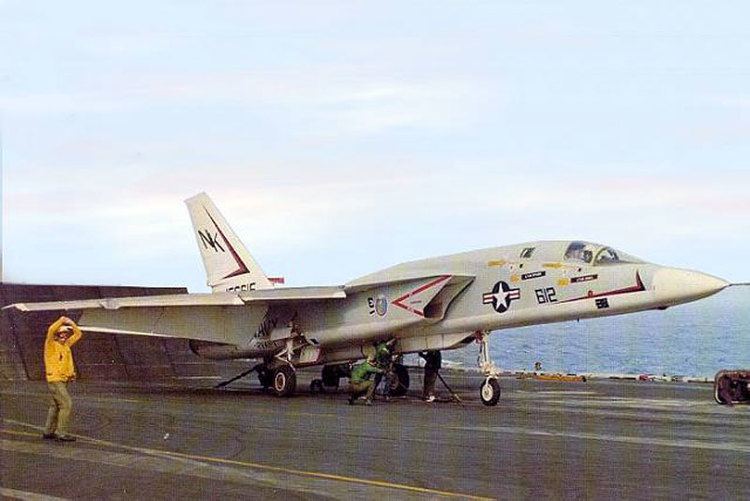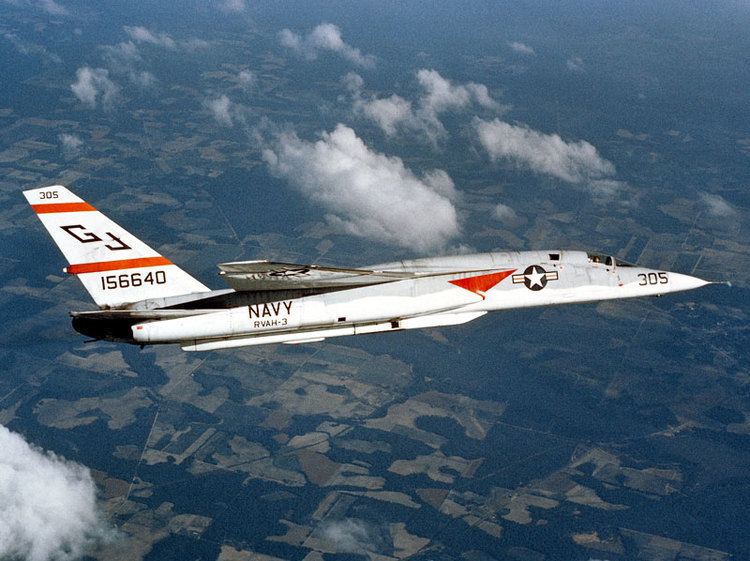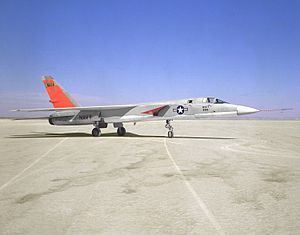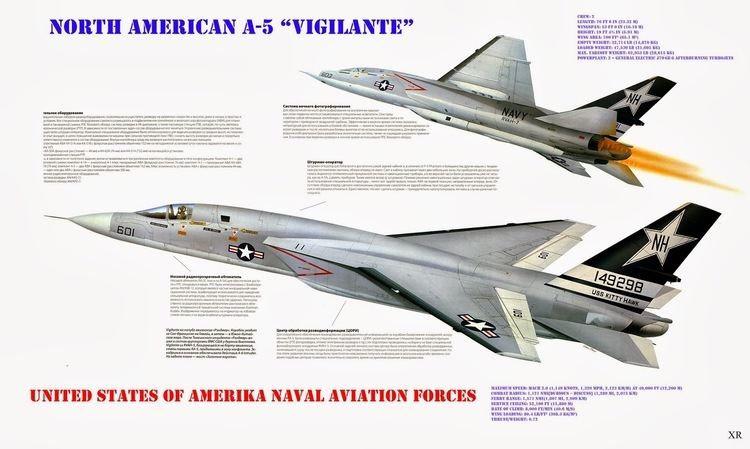Top speed 2,123 km/h Wingspan 16 m Weight 14,870 kg | Range 2,909 km Length 23 m | |
 | ||
North american a 5 vigilante
The North American A-5 Vigilante was a carrier-based supersonic bomber designed and built by North American Aviation for the United States Navy. Its service in the nuclear strike role to replace the Douglas A-3 Skywarrior was very short; however, as the RA-5C, it saw extensive service during the Vietnam War in the tactical strike reconnaissance role. Prior to the unification of the Navy designation sequence with the Air Force sequence in 1962, it was designated the A3J Vigilante.
Contents
- North american a 5 vigilante
- Design and development
- Operational history
- Records
- Variants
- Operators
- Aircraft on display
- Specifications A 5A Vigilante
- References

North american a 5 vigilante
Design and development

In 1953, North American Aviation began a private study for a carrier-based, long-range, all-weather strike bomber, capable of delivering nuclear weapons at supersonic speeds. This proposal, the North American General Purpose Attack Weapon (NAGPAW) concept, was accepted by the United States Navy, with some revisions, in 1955. A contract was awarded on 29 August 1956. Its first flight occurred two years later on 31 August 1958 in Columbus, Ohio.

At the time of its introduction, the Vigilante was one of the largest and by far the most complex aircraft to operate from a United States Navy aircraft carrier. It had a high-mounted swept wing with a boundary-layer control system (blown flaps) to improve low-speed lift. There were no ailerons. Roll control was provided by spoilers in conjunction with differential deflection of the all-moving tail surfaces. The use of aluminum-lithium alloy for wing skins and titanium for critical structures was also unusual. The A-5 had two widely spaced General Electric J79 turbojet engines (the same as used on the McDonnell Douglas F-4 Phantom II fighter), fed by intake ramps and a single large all-moving vertical stabilizer. Preliminary design studies had employed twin vertical fin/rudders. The wings, vertical stabilizer and the nose radome folded for carrier stowage. The Vigilante had a crew of two seated in tandem, a pilot and a bombardier-navigator (BN) (reconnaissance/attack navigator (RAN) on later reconnaissance versions) in individual North American HS-1A ejection seats.

Despite being designated by the US Navy as a "heavy", the A-5 was surprisingly agile for such a large aircraft. Without the drag of bombs or missiles, even escorting fighters found that the clean airframe and powerful engines made the Vigilante very fast at high and low altitudes. However, its high approach speed and high angle of attack in the landing configuration made returning to the aircraft carrier a challenge for inexperienced or unwary pilots.

The Vigilante had advanced and complex electronics when it first entered service. It had one of the first "fly-by-wire" systems on an operational aircraft (with mechanical/hydraulic backup) and a computerized AN/ASB-12 nav/attack system incorporating a head-up display ("Pilot's Projected Display Indicator" (PPDI), one of the first), multi-mode radar, radar-equipped inertial navigation system (REINS, based on technologies developed for North American's Navaho missile), closed-circuit television camera under the nose, and an early digital computer known as "Versatile Digital Analyzer" (VERDAN) to run it all.
Given its original design as a carrier-based, supersonic, nuclear heavy attack aircraft, the Vigilante's main armament was carried in a novel "linear bomb bay" between the engines in the rear fuselage, which provided for positive separation of the bomb from the aircraft at supersonic speeds. The single nuclear weapon, commonly the Mk 28 bomb, was attached to two disposable fuel tanks in the cylindrical bay in an assembly known as the "stores train". A set of extendable fins was attached to the aft end of the most rearward fuel tank. These fuel tanks were to be emptied during the flight to the target and then jettisoned with the bomb by an explosive drogue gun. The stores train was propelled rearward at about 50 feet per second (30 knots) relative to the aircraft. It thereafter followed a typical ballistic path.
In practice, the system was not reliable and no live weapons were ever carried in the linear bomb bay. In the RA-5C configuration, the bay was used solely for fuel. On three occasions, the shock of the catapult launch caused the fuel cans to eject onto the deck; this resulted in one aircraft loss.
The Vigilante originally had two wing pylons, intended primarily for drop tanks. The second Vigilante variant, the A3J-2 (A-5B), incorporated internal tanks for an additional 460 gallons of fuel (which added a pronounced dorsal "hump") along with two additional wing hardpoints, for a total of four. In practice the hardpoints were rarely used. Other improvements included blown flaps on the leading edge of the wing and sturdier landing gear.
The reconnaissance version of the Vigilante, the RA-5C, had slightly greater wing area and added a long canoe-shaped fairing under the fuselage for a multi-sensor reconnaissance pack. This added an APD-7 side-looking airborne radar (SLAR), AAS-21 infrared line scanner, and camera packs, as well as improved ECM. An AN/ALQ-61 electronic intelligence system could also be carried. The RA-5C retained the AN/ASB-12 bombing system, and could, in theory, carry weapons, although it never did in service. Later-build RA-5Cs had more powerful J79-10 engines with afterburning thrust of 17,900 lbf (80 kN). The reconnaissance Vigilante weighed almost five tons more than the strike version with almost the same thrust and an only modestly enlarged wing. These changes cost it acceleration and climb rate, though it remained fast in level flight.
The Royal Australian Air Force considered the RA-5C Vigilante as a replacement for its English Electric Canberra. The McDonnell F-4C / RF-4C, Dassault Mirage IVA, and the similar BAC TSR-2 was also considered. However, the TFX (later the F-111C Aardvark) was accepted.
Operational history
Designated A3J-1, the Vigilante first entered squadron service with Heavy Attack Squadron THREE (VAH-3) in June 1961 at Naval Air Station Sanford, Florida, replacing the Douglas A-3 Skywarrior in the heavy attack, e.g., "strategic nuclear strike" role. All variants of the Vigilante were built at North American Aviation's facility at Port Columbus Airport in Columbus, Ohio, alongside the North American T-2 Buckeye, T-39 Sabreliner and OV-10 Bronco.
Under the Tri-Services Designation plan implemented under Robert McNamara in September 1962, the Vigilante was redesignated A-5, with the initial A3J-1 becoming A-5A and the updated A3J-2 becoming A-5B. The subsequent reconnaissance version, originally A3J-3P, became the RA-5C.
The Vigilante's early service proved troublesome, with many teething problems for its advanced systems. Although these systems were highly sophisticated, the technology was in its infancy, and its reliability was poor. Although most of these reliability issues were eventually worked out as maintenance personnel gained greater experience with supporting these systems, the aircraft tended to remain a maintenance-intensive platform throughout its career.
The A-5's service coincided with a major policy shift in the U.S. Navy's strategic role, which switched to emphasize submarine-launched ballistic missiles rather than manned bombers. As a result, in 1963, procurement of the A-5 was ended and the type was converted to the fast reconnaissance role.
The first RA-5Cs were delivered to Heavy Attack Squadron THREE (VAH-3), the A-5A and A-5B Replacement Air Group (RAG) / Fleet Replacement Squadron (FRS), subsequently redesignated as Reconnaissance Attack Squadron Three (RVAH-3), at NAS Sanford, Florida in July 1963. As they transitioned from the attack version to the reconnaissance version, all Vigilante squadrons were subsequently redesignated from VAH to RVAH.
Under the cognizance of Commander, Reconnaissance Attack Wing One (COMRECONATKWING ONE), a total of 10 RA-5C squadrons were ultimately established. RVAH-3 continued to be responsible for the stateside-based RA-5C training mission of flight crews, maintenance and support personnel, while RVAH-1, RVAH-5, RVAH-6, RVAH-7, RVAH-9, RVAH-11, RVAH-12, RVAH-13 and RVAH-14 routinely deployed aboard Forrestal, Saratoga, Ranger, Independence, Kitty Hawk, Constellation, Enterprise, America, John F. Kennedy and eventually the Nimitz-class aircraft carriers to the Atlantic, Mediterranean and Western Pacific.
Eight of ten squadrons of RA-5C Vigilantes also saw extensive service in Vietnam starting in August 1964, carrying out hazardous medium-level post-strike reconnaissance missions. Although it proved fast and agile, 18 RA-5Cs were lost in combat: 14 to anti-aircraft fire, 3 to surface-to-air missiles, and 1 to a MiG-21 during Operation Linebacker II. Nine more RA-5Cs were lost in operational accidents while serving with Task Force 77. Due, in part, to these combat losses, 36 additional RA-5C aircraft were built from 1968 to 1970 as attrition replacements.
In 1968, Congress closed the aircraft's original operating base of NAS Sanford, Florida and transferred the parent wing, Reconnaissance Attack Wing One, all subordinate squadrons, and all aircraft and personnel to Turner AFB, a Strategic Air Command (SAC) Boeing B-52 Stratofortress and Boeing KC-135 base in Albany, Georgia. The tenant SAC bomb wing was then inactivated and control of Turner AFB was transferred from the Air Force to the Navy with the installation renamed Naval Air Station Albany. In 1974, after barely six years of service as a naval air station, Congress opted to close NAS Albany as part of a post-Vietnam force reduction, transferring all RA-5C units and personnel to NAS Key West, Florida.
Despite the Vigilante's useful service, it was expensive and complex to operate and occupied significant amounts of precious flight deck and hangar deck space aboard both conventional and nuclear-powered aircraft carriers at a time when carrier air wings, with the introduction of the F-14 Tomcat and S-3 Viking, were averaging 90 aircraft, many of which were larger than the predecessors. With the end of the Vietnam War, disestablishment of RVAH squadrons began in 1974, with the last Vigilante squadron, RVAH-7, completing its final deployment to the Western Pacific aboard Ranger in late 1979. The final flight by an RA-5C took place on 20 November 1979 when a Vigilante departed NAS Key West, Florida. Reconnaissance Attack Wing One was subsequently disestablished at NAS Key West, Florida in January 1980.
The Vigilante did not end the career of the A-3 Skywarriors, which would carry on as photo reconnaissance aircraft, electronic warfare platforms, aerial refueling tankers, and executive transport aircraft designated as RA-3A/B, EA-3A/B, ERA-3B, EKA-3B KA-3B, and VA-3B, into the 1980s and early 1990s.
Fighters replaced the RA-5C in the carrier-based reconnaissance role. The RF-8G version of the Vought F-8 Crusader, modified with internal cameras, had already been serving in two light photographic squadrons (VFP-62 and VFP-63) since the early 1960s, operating from older aircraft carriers unable to support the Vigilante. The Marine Corps' sole photographic squadron (VMFP-3) would also deploy aboard aircraft carriers during this period with RF-4B Phantom II aircraft. These squadrons superseded the Vigilante's role by providing detachments from the primary squadron to carrier air wings throughout the late 1970s and early-to-mid-1980s, until the transfer of the recon mission to the Navy's fighter squadron (VF) community operating the Grumman F-14 Tomcat.
Select models of the F-14 Tomcat would eventually carry the multi-sensor Tactical Air Reconnaissance Pod (TARPS) and the Digital Tactical Air Reconnaissance Pod (D-TARPS). Following up to present day, the weight of fighters such as the F-14 Tomcat and Boeing F/A-18E/F Super Hornet have evolved into the same 62,950 lb (28,550 kg) class as the Vigilante. With the retirement of the F-14, the Boeing F/A-18E/F Super Hornet strike fighters and EA-18G Growler electronic warfare aircraft are purported to cover the strike, reconnaissance, tanker and electronic warfare roles of the F-14 Tomcat, A-6E Intruder, A-7E Corsair II, RF-8G Crusader, RA-5C, KA-6D Intruder, Grumman EA-6B Prowler, S-3B Viking, ES-3A Shadow and EA-3B Skywarrior.
Records
On 13 December 1960, Navy Commander Leroy Heath (Pilot) and Lieutenant Larry Monroe (Bombardier/Navigator) established a world altitude record of 91,450.8 feet (27,874.2 m) in an A3J Vigilante carrying a 1,000 kilogram payload, beating the previous record by over four miles (6 km). This new record held for over 13 years.
The attempt was accomplished by reaching a speed of Mach 2.1, then pulling up to create a ballistic trajectory beyond the altitude its wings could continue to function. The engines flamed out in the thin atmosphere, and the aircraft rolled onto its back. This had already been experienced in previous flights, and so the pilot simply released the controls and the aircraft regained control naturally as it descended back into the thicker air of the lower atmosphere.
Variants
Operators
Aircraft on display
An additional example of an A-5A destined for restoration as a museum aircraft, BuNo 146698, was destroyed when it was being relocated by Army helicopter from Naval Air Engineering Station Lakehurst, New Jersey to a new location. When the A-5A became unstable in flight, the helicopter crew was forced to jettison the aircraft from altitude.
.
Specifications (A-5A Vigilante)
Data from North American Rockwell A3J (A-5) Vigilante, Combat Aircraft since 1945
General characteristics
Performance
Armament
Avionics
Systems carried by A-5 or RA-5C
